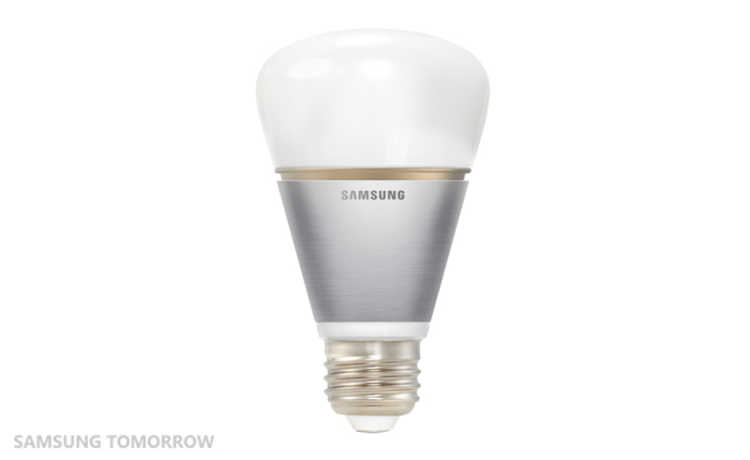It’s appropriate that the Internet of things should creep into our lives as a new kind of lightbulb, a riff on Thomas Edison’s most famous electrical invention. This week, Samsung helped that transition along, joining LG and Philips in turning lightbulbs into peripherals.
The company’s new line of LED Smart Bulbs, launching next week at the Light + Building 2014 tradeshow in Frankfurt, can be controlled directly from an app on an iOS or Android smartphone through Bluetooth. Models include “lamps with a swivel-head PAR, a decorative classic design LED lamp, and an L-tube series.”
As many as 64 Samsung Smart Bulbs can fall under one person’s control, which is useful when you’re having a well-lit dinner in a banquet hall. If you want to change the mood to a romantic banquet, the Smart Bulb can dim down to 10 percent brightness and be tuned to shades of white ranging from 2,700K to 6,500K.
Samsung hasn’t announced a price yet, but don’t be surprised if it’s around LG’s tab of $32 per bulb. On the bright side, so to speak, the LG and Samsung bulb are each rated with a lifetime of an estimated 15,000 hours, which should cover you for 10 years if you don’t read by lamplight all night every night. On the other hand, standard LED lamps are often rated at 25,000 hours to 50,000 hours.
LG’s 10W LED bulb, which is only available in South Korea at the moment, employs Wi-Fi or Bluetooth. It can “blink” when you have a call coming into your smartphone. One assumes that you could assign separate blinking patterns for different callers.
This could be particularly useful when you’re wearing those sound-sealing headphones while you’re videogaming your way through alien hordes; your house lamp blinks, telling you that your mom’s calling.
The LG lamp can also serve as a visual alarm clock, glowing brighter until you think the sun’s come up. Or it can be the modern equivalent of a strobe light, pulsating to the beat of your smartphone’s playlist. It can also be set to remotely turn on and off, so any would-be robbers think you’re home (or a dark-hating ghost is).
Lest you think your home is your castle, Philips is determined to make it into a platform, starting with its Hue smart bulb and a host of additions. It is encouraging third-party developers to create apps for the Hue, which can shine in different colors as well as varying brightness. Expect to see apps for party lighting settings, getting your date in the mood, or getting you out of a mood.
Brad Shimmin, an analyst for industry research firm Current Analysis, thinks this day has been building inevitably, through such milestones as the Clapper light and Bill Gates’ construction of his prescient home years ago.
“An open standard [for smart lightbulbs] could be a tremendous cost savings for businesses,” he pointed out, so electrical costs can be controlled as tightly as the budget for paperclips.
Which could make up for watching your lamps try to dance to your music.
VentureBeat's mission is to be a digital town square for technical decision-makers to gain knowledge about transformative enterprise technology and transact. Learn More

